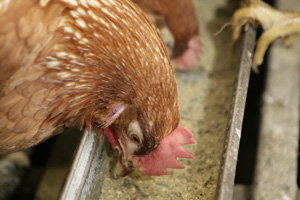Strategic and profitable approach to poultry worming

It’s been a miserable winter for poultry and their keepers. Many producers are familiar with the idea of regular or routine worming but this spring could be the time to review whether that routine is as good as people say.
Even birds that look healthy can be infected with parasitic worms that can lead to poor egg production, so treatment can be highly cost effective. In fact, so cost effective that one trial showed that regular treatment with flubendazole (Flubenvet 5% w/w Premix) could increase egg production by 20 eggs per hen over the standard production period – equating to an extra £10 in egg sales for every £1 spent on treatment1.
So what’s the ‘ideal’ worming regime? Frequent treatment is desirable on infected premises, but vets at Elanco Animal Health say for most commercial poultry producers a regular six-week worming is going to produce the best results2. This is based on a treatment interval in line with the prepatent period of the worms – the time it takes for a newly infected bird to start shedding parasitic worm eggs into the environment. This more strategic approach contains worm burdens in the birds and minimises environmental contamination.
All of this is highly relevant to those in both indoor, and more especially, free-range- operations. An infected bird can produce many infectious worm eggs that build up in the environment. After a few years, or months in some instances, the soil can become contaminated with an increasingly heavy worm burden. In most cases you won’t see this with the naked eye and it’s only when a high worm egg count is detected in the droppings or birds become ill, that the problem will become obvious.
This contamination leads to a high infection pressure, which in turn can increase worm burdens carried by the birds. In these circumstances more frequent worming will be needed to get on top of the worm problem and break this cycle of continued heavy contamination.
This year, the problem of parasiticworms may be even more acute: NADIS parasite forecasts have highlighted that rainfall has consistently been running well above average for the last quarter.2 This means it’s likely that worm eggs in the environment have been protected in mud and not destroyed by desiccation or exposure to sunlight, potentially allowing more infectiveworm eggs to survive into the spring this year. Being more strategic about worming could be the most profitable decision producers make this year.
References:
1. Trial conducted by Janssen Animal Health 2010
2. NADIS parasite forecast February 2013
Join 31,000+ subscribers
Subscribe to our newsletter to stay updated about all the need-to-know content in the poultry sector, three times a week. Beheer
Beheer








 WP Admin
WP Admin  Bewerk bericht
Bewerk bericht